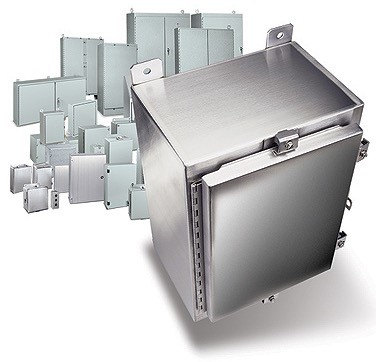NEMA rating is one of those standards that is at times misunderstood or even ignored. However, it is an important specification that must be considered when buying a NEMA rated product to ensure the safety of personnel and equipment. For this post, let’s use enclosures as an example of a NEMA rated product.

NEMA rated enclosures are designed to house all kinds of electrical components from simple terminal blocks, to industrial automation systems, to high voltage switchgear. Other uses include industrial applications to house motor controls, drives, PLC/PC control systems, pushbuttons, and termination systems. These enclosures are specifically designed to meet the National Electrical Manufacturers Association (NEMA) standards for performance and protection of the electrical equipment installed within them. All NEMA enclosures are given a NEMA rating according to the types of applications the enclosure serves. These ratings are based mainly on the conditions to which the enclosure will be exposed.
In my experience with industrial facilities and suppliers, I have seen a number of installations where enclosures were not properly selected for the service they’re supposed to provide. I have heard people say, “I don’t care about the NEMA rating, I just need an enclosure to put some equipment in”. If this statement is true, then you could actually just get a cardboard box or a plastic sheet and cover the equipment, instruments or wiring. But of course, that wouldn’t be good enough, it would be dangerous, and whatever it is you’re trying to protect will probably not last very long.

Now, let’s think about the real reason you might shop for an enclosure. Maybe you just have a small number of electrical connections with a few breakers, perhaps some type of meter. My guess would be that the first thing you would try to protect is facility personnel from serious or fatal injury by accidentally touching the electrical wires and/or connections. Well, if you take a peek at the table for NEMA classifications included below, NEMA 1 reads, “provides a degree of protection against incidental contact with the enclosed equipment”. Congratulations! Now you know you need at least a NEMA 1 rated enclosure.
If you noticed, I said at least. This is because you need to determine if all requirements to safely and properly protect your equipment and personnel have been met. So, let’s assume that the other conditions to consider are that the enclosure will be located outdoors and because of this, it will be subject to rain, windblown dust, maybe sleet and possibly some ice formation. If you look at the table, you just upgraded your enclosure from NEMA 1 to at least a NEMA 3. However, maybe the conditions are hazardous or corrosive, there are chemical fumes, or the atmosphere is humid, and you want to ensure none of these affect the components in the enclosure. Now you need a higher rated NEMA enclosure.
We can keep going but hopefully you can see the importance of selecting the appropriate NEMA rated enclosure for your specific use and conditions. It is critical that you read the description of the NEMA ratings and select the best one that applies to your requirements.
NEMA Classifications Table for Enclosures
| NEMA Type | Provides a degree of protection against… |
| 1 | Incidental contact with the enclosed equipment for indoor enclosures |
| 2 | Small amounts of falling water and dirt for indoor enclosures |
| 3 | Windblown, dust, rain, sleet and external ice formation. Intended primarily for outdoor enclosures but also for indoor. |
| 3R | Falling rain, sleet, snow and external ice formation when used outdoors and for dripping water when used indoors. Typically used for wiring and junction boxes |
| 3S | Windblown dust, rain, sleet and provides operation of external mechanisms when ice laden. Intended primarily for outdoor enclosures but also for indoor enclosures. |
| 4 | A pressurized stream of water where an occasional wash down or where machine tool cutter coolant is used. For indoor and outdoor use. |
| 4X | Corrosive materials and caustic cleaners. These enclosures are made of stainless steel, aluminum, fiberglass or polycarbonate and used for food, beverage and applications where total wash downs with disinfectants occur repeatedly. For indoor and outdoor use. |
| 5 | Settling airborne dust, falling dirt and dripping non-corrosive liquids. Intended for indoor use. |
| 6 | Water entry during a temporary submersion at a limited depth. Intended for indoor and outdoor. |
| 6P | Water entry during a prolonged submersion at a limited depth. Intended for indoor and outdoor. |
| 12 | Falling dirt, dripping non-corrosive liquids, airborne contaminants and non-pressurized water and oil. These enclosures have no knockouts and are used for indoor applications such as automation control, drives systems, packaging, material handling and manufacturing applications. |
| 12K | Dust, falling dirt, dripping non-corrosive liquids (except at knockouts). These are enclosures with knockouts for indoor use. |
| 13 | Dust, spraying of water, oil and non-corrosive coolant. Intended for indoor use. |

Your enclosure’s primary function is to protect the equipment enclosed inside from the surrounding environment and personnel from the hazards within the enclosure. Therefore, you need to understand the environment where the enclosure will be located and select the appropriate level of protection. Keep in mind that it is just as important not to over-specify the protection level of your enclosure as it is to under-specify, as increasing the protection level typically increases the cost of the enclosure.
Also, remember that there are other factors to consider when selecting an enclosure; you can find more information about enclosures and accessories in our website’s “Enclosures” category and at our library in the “What to Know When Selecting an Enclosure” post.

